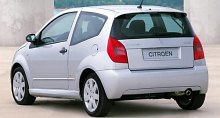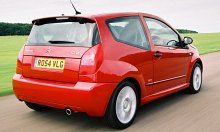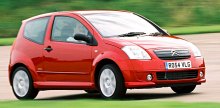|
Citroen C2
Debut: 2003
Maker: Citroen
Predecessor:
Saxo |
|
 C2
replaces Saxo (which was a rebadged Peugeot 106) as the smallest model
in Citroen’s family chart. Basically, it is a shortened, 3-door version
of the C3, targeting at young people as personal transport. C2
replaces Saxo (which was a rebadged Peugeot 106) as the smallest model
in Citroen’s family chart. Basically, it is a shortened, 3-door version
of the C3, targeting at young people as personal transport.
The
C2 is built
on the C3
platform but with wheelbase shortened by 15cm in the expense of rear
passenger
room. That means, while the driver enjoys almost as much room as in C3,
the rear is limited to a couple of small independent seats with very
limited
legroom and average headroom. Regular size adults won’t fit into it
unless
for short journey.
Predictably,
bounded by the
limited length the boot is small. However, access to the boot is easy,
thanks to a two-piece tailgate. The upper tailgate can be opened in
limited
space. The lower tailgate hinge at the bottom - the same as C3 Pluriel
- and can therefore load longer items or can sit people up to 100kg.
60%
components
are shared
with C3, including suspensions (front strut, rear torsion-beam),
engines,
gearbox, steering (electric assistance), dashboard.... but Citroen is
quite
successful to distinguish both cars in looks. The C2 has a sharper,
cleaner
and sportier design than the roundy C3. It is also cute enough to
attract
young buyers.
 With
shorter length and fewer doors, the C2 is slightly lighter than the
equivalent
C3, hence boosting brisker performance. The hottest version VTR employs
the company’s popular 1.6-litre 16V engine with 110 horsepower and a
"Sensodrive"
clutchless 5-speed manual gearbox. 0-60mph can be done in an estimated
10.3 seconds. That said, it is no where near the outgoing Saxo VTS
(120hp
8.0 sec), blame to the slow gearbox and the ever increasing weight
required
by today’s safety, comfort and refinement concern. To put the C2 into
hot
hatch segment, Citroen will need to equip it with the 2.0-litre 16V
engine
and manual gearbox from Peugeot 206S16. With
shorter length and fewer doors, the C2 is slightly lighter than the
equivalent
C3, hence boosting brisker performance. The hottest version VTR employs
the company’s popular 1.6-litre 16V engine with 110 horsepower and a
"Sensodrive"
clutchless 5-speed manual gearbox. 0-60mph can be done in an estimated
10.3 seconds. That said, it is no where near the outgoing Saxo VTS
(120hp
8.0 sec), blame to the slow gearbox and the ever increasing weight
required
by today’s safety, comfort and refinement concern. To put the C2 into
hot
hatch segment, Citroen will need to equip it with the 2.0-litre 16V
engine
and manual gearbox from Peugeot 206S16.
Apart
from
lifeless electric
power steering, C2 VTR is actually quite satisfying to drive. Its
handling
is easy and predictable. With enough lift-off oversteer, it is never
boring
to drive. 195mm tires provide abundance of grip. Suspension setup is
particularly
successful, keeping body roll in check while bringing good ride
quality.
That
said, C2
didn’t bring
us any surprise. You may remember Fiat Uno broke new ground in
packaging,
Volkswagen Polo set new standards for quality and Ford Ka lifted the
game
of handling. These cars have their places in automotive history. In
contrast,
Citroen C2 will be remembered for nothing. It does most things well,
but
not special enough. |
| The
above report was last updated on 24 Sep
2003. All Rights Reserved. |
C2 VTS
|
 Cars
do not need to be sophisticated to be fun. The best hot hatches in
history
- Peugeot 205GTi, 106GTi and Golf GTi Mk1 etc. - were all very simple
cars.
The key to success is a compact size, lightweight body and a chassis
tune
to respond keenly to the driver. These qualities gave the outgoing
Citroen
Saxo VTS a good reputation in enthusiasts circle. Cars
do not need to be sophisticated to be fun. The best hot hatches in
history
- Peugeot 205GTi, 106GTi and Golf GTi Mk1 etc. - were all very simple
cars.
The key to success is a compact size, lightweight body and a chassis
tune
to respond keenly to the driver. These qualities gave the outgoing
Citroen
Saxo VTS a good reputation in enthusiasts circle.
Now
Saxo is
succeeded by
C2, thus Saxo VTS also gave way to C2 VTS. The latter is derived from
the
C2 VTR, with tuned engine, steering, suspension and gearbox to deliver
more driver appeal that VTR really lacking. The result is a welcomed
improvement,
but still fail to come close to Saxo VTS in terms of driving fun. You
know,
the C2 platform is not a good starting point to build a hot hatch.
Despite
of modern level of chassis stiffness, grip and refinement, it has a
couple
of drawbacks compare with its predecessor. Firstly, its higher center
of
gravity deteriorates either body control or, if compensated by stiffer
suspension setup, ride quality. Secondly, its money and fuel-saving
electric
power steering filters all information coming from the front wheels,
making
the steering wheel as lifeless as playing video games. Without a
complete
redesign, these problems are carried over to the VTS.
So, how does
it
corner? with
10mm lower ride height, stiff springs, dampers and anti-roll bars than
VTR, it corners stable and responsive enough, while the ride is firm
but
not unacceptable. The 195/45 VR16 tires, same as VTR, continues to
deliver
abundance of grip. The quickened steering rack (shortened from 2.8 to
2.6
turns lock to lock) allows really sharp turn-in. So the early
impression
is a revelation, much sportier than the VTR. Dig deeper, however, and
you
will find its talent is no where near Saxo. The lifeless steering is
certainly
the biggest flaw for a hot hatch, but other controls are not much
better
- brake travel too long, gearshift imprecise, poor steering wheel and
pedals
position.... the C2 has too many flaws to involve its driver.
 VTS
employs a tuned version of VTR’s 1.6-litre 16V engine. By improving
breathing
to intake and exhaust, revised cam timing, stiffer valve springs and
revised
fuel injection, it liberates another 500 rpm at the top end. That means
the engine can now rev to 7000 rpm consistently and even 7200 rpm in a
short period. At 6500 rpm, it generates the maximum power 123 hp, 13hp
up from VTR. Torque is reduced slightly to 105 lbft, but it arrives at
only 3750 rpm, so tractability is not a problem. A close-ratio 5-speed
manual gearbox replaces the VTR’s clutchless manual. VTS
employs a tuned version of VTR’s 1.6-litre 16V engine. By improving
breathing
to intake and exhaust, revised cam timing, stiffer valve springs and
revised
fuel injection, it liberates another 500 rpm at the top end. That means
the engine can now rev to 7000 rpm consistently and even 7200 rpm in a
short period. At 6500 rpm, it generates the maximum power 123 hp, 13hp
up from VTR. Torque is reduced slightly to 105 lbft, but it arrives at
only 3750 rpm, so tractability is not a problem. A close-ratio 5-speed
manual gearbox replaces the VTR’s clutchless manual.
Looking the
engine in isolation,
perhaps it is stronger than the one used by Saxo VTS. Unfortunately,
the
new generation car also carries 100 more kilograms than its
lean-constructed
predecessor, no wonder Autocar found 0-60 mph slipped by almost a
second
!
However, speed is
not the
biggest problem here, but driver involvement is. Before Citroen sort it
out (unlikely during the life of C2), this car is not going to be
popular
in the enthusiasts circle. |
| The
above report was last updated on 2 Oct 2004. All
Rights Reserved. |
|
|